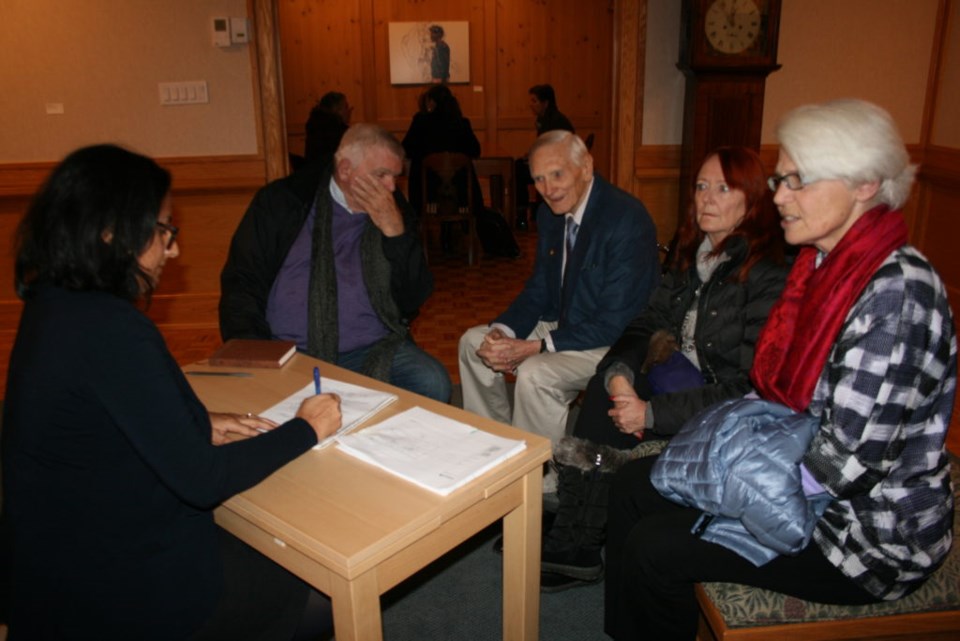
What the future holds for the RiverBrink Art Museum in Queenston should be more certain in a few months.
The first step toward that future coming to light took place last Friday, as the museum hosted an open house to kick off a feasibility study on its growth.
Curator Debra Antoncic was pleased with the turnout, as almost 30 community members showed up to meet the representatives from Lord Cultural Resources. The evening was set up in a round-table of sorts. Visitors were invited to sit with three principals from the consulting company, including president Gail Lord, who has a weekend home in Niagara-
on-the-Lake.
Lord’s station on the round table focused on the collections of the museum. RiverBrink is known for housing The Samuel E. Weir Collection of more than 1,400 important and valuable Canadian, European and American art pieces. It was clear many in attendance wanted any future changes to protect the curatorial excellence and integrity of the museum’s exhibits.
Former RiverBrink director Richard Baker said, “this has always been a very high quality gallery that exhibits art of a very high standard and historical interest. It’s very important to maintain that rather elevated and sophisticated atmosphere that it has achieved over the years it’s been here.”
Longtime volunteer Fred Farnham has seen a few changes to the museum over the years. He worries that future expansion could move RiverBrink further away from Samuel Weir’s original vision for the building, which was built as the lawyer’s summer home.
Farnham has been volunteering since before 1996, when RiverBrink’s east-side porch was converted into what is now known as the “long gallery.” Marina Ramirez, Lord’s senior consultant of facility planning, met with visitors in that room to learn what they liked about the museum’s architecture, and to hear their suggestions for changes.
Susan Dods told Ramirez she feels RiverBrink needs more space to display more of the Weir collection on a permanent basis. Currently, the “long gallery” is being used to house “Compounding Vision,” a temporary exhibition of the works of Toronto artist Charmaine Lurch. Meanwhile, much of the Weir Collection remains in storage.
Baker feels strongly that changes need to be made to the front entrance to the museum. “The appearance of the front of the building needs to be improved, so people don’t drive by and say it’s just another house. It’s just a domestic front door. It’s absolutely unremarkable.
“You could just change the materials, you could perhaps make it look a little bigger, you could make it an antechamber, you could use glass, put a modest sign upstairs that says ‘this is the RiverBrink Art Museum,’ something modest, but powerful and inviting.”
Baker was one of many visitors who lamented the fact that RiverBrink is a bit of a “hidden gem.” Many in attendance expressed to Ted Silberberg, Lord’s senior principal, market and financial planning, that for the museum to survive, it’s important that attendance improves.
Attendance this year was up, Silberberg believes, because free admission had been sponsored from February through August. That led to 3,900 visitors for 2019, 1,300 more than the previous year, when there was an attendance charge.
Silberberg’s role in the feasibility study focuses on the financial viability of RiverBrink. He was heartened by the number of people who showed up to express their interest in its future.
“There is substantial room for growth in all attendance and revenue areas,” says Silberberg. “Being in Niagara-on-the-Lake, having access to substantial markets both for Niagara-on-the-Lake and Niagara Falls, having a strong pass-by traffic, people here for the wineries, a demographic whom I assume would have a strong interest in art as well — these are all opportunities.”
He went on to say, “the objective of our study is to build on the opportunities, look to mitigate the challenges, and help to increase attendance, earned income, and the conditions for more private and government support.”
A number of different ideas arose to capitalize on those opportunities.
One participant posited the idea of selling the property, and moving the collection into town to the former hospital site. This was said to be a way to capture more walk-up traffic. Another thought a sculpture garden on the surrounding grounds would draw more visitors.
Others focused on rentals as a way to increase revenue. Silberberg tossed out the idea of using RiverBrink’s river-side locale more effectively, perhaps setting up a tent to host weddings and other functions throughout the summer months.
Partnerships with other Niagara museums, such as Rodman Hall Art Centre in St. Catharines, which sees 30,000 visitors cross its threshold each year, was another solution. Interestingly enough, Rodman Hall’s current curator, Marcie Bronson was in attendance Friday, as was Sarah Maloney Kaufman, managing director and curator of the Niagara Historical Museum. Lord Cultural Resources is also consulting on upcoming changes to that museum, which were unveiled in November.
A meeting with RiverBrink’s board of directors preceded the open house. The next step for Lord, Silberberg and Ramirez will be to meet with the local school boards, chambers of commerce, and other organizations to gather input on the museum’s role in the community. That process should take up the next few weeks and months, said Silberberg.
According to Antoncic, there is no timeline or budget yet for any changes, upgrades or expansions to RiverBrink. “We’re conscious that there are a number of expansions going on, there are a lot of big projects that organizations are raising money for now, so we’re just really trying to start out and find out if this is something we can even dream of doing.”
One thing is certain, though. Like the Niagara Historical Museum, RiverBrink will have to install an elevator to meet the standards of the Accessibility for Ontarians with Disabilities Act by 2025.
Antoncic welcomes input from those who were unable to attend the open house. Questions or concerns about RiverBrink can be sent to her via email at [email protected].